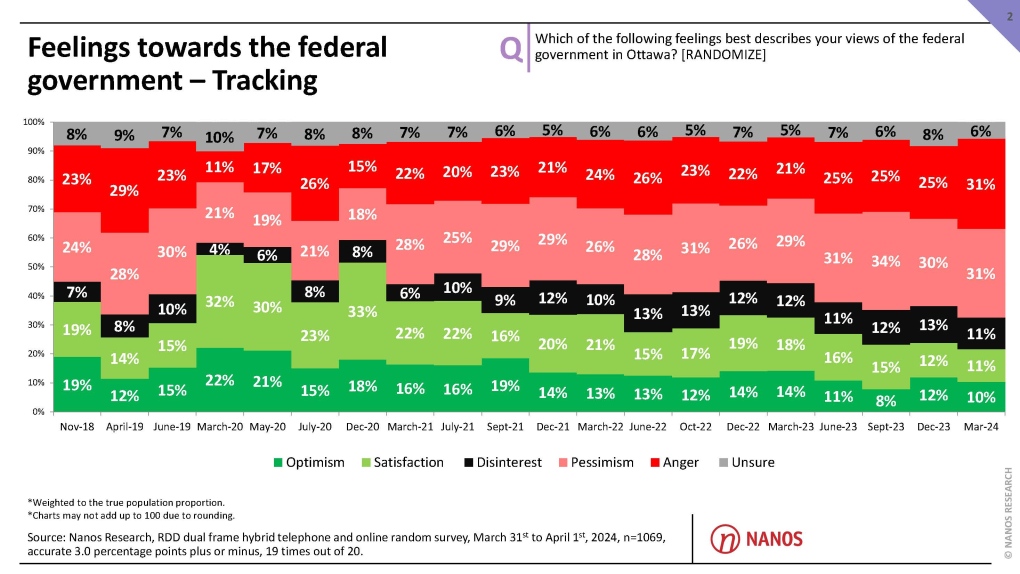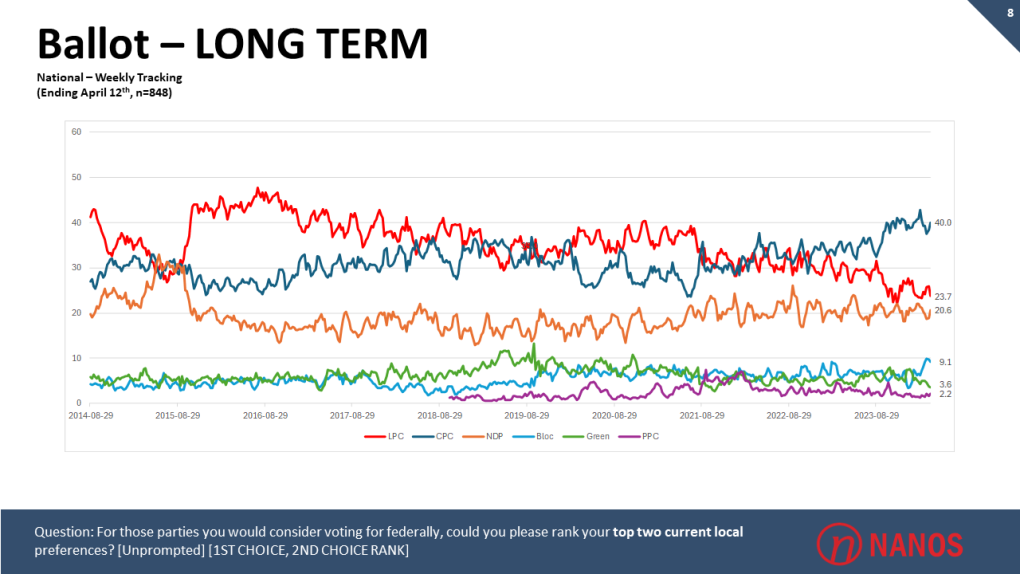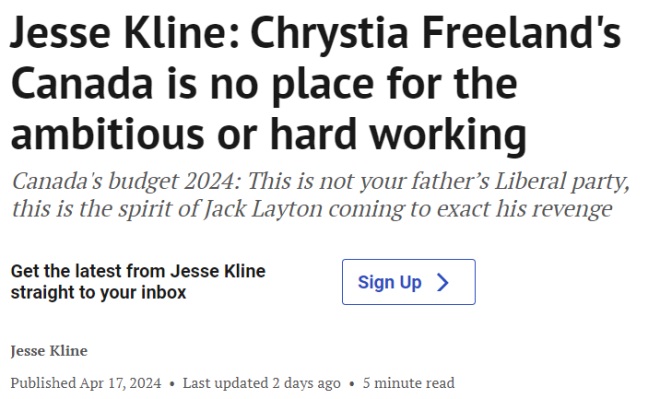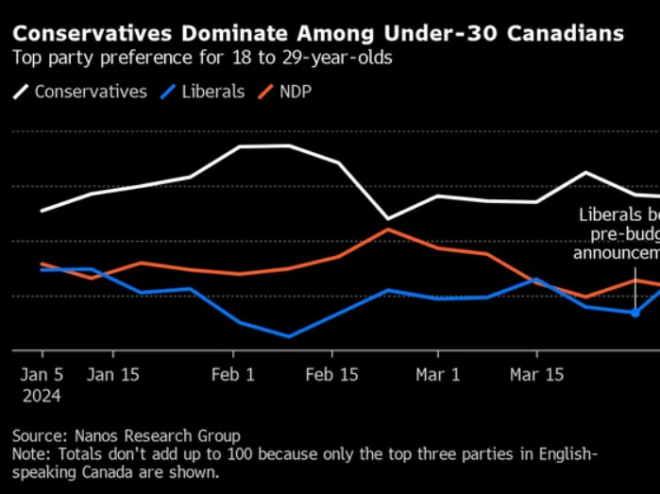Most Canadians in March reported feeling angry or pessimistic towards the federal government than at any point in the last six years, according to a survey by Nanos Research(opens in a new tab).
Nanos has been measuring Canadians' feelings of optimism, satisfaction, disinterest, anger, pessimism and uncertainty toward the federal government since November 2018.
The latest survey found that optimism had crept up slightly to 10 per cent since hitting an all-time low of eight per cent in September 2023.
However, 62 per cent of Canadians said they feel either pessimistic or angry, with respondents equally split between the two sentiments. (Nanos Research)
(Nanos Research)
"What we've seen is the anger quotient has hit a new record," Nik Nanos(opens in a new tab), CTV's official pollster and Nanos Research founder, said in an interview with CTV News' Trend Line on Wednesday.
Only 11 per cent of Canadians felt satisfied, while another 11 per cent said they were disinterested.
Past survey results show anger toward the federal government has increased or held steady across the country since March 2023, while satisfaction has gradually declined.
Will the budget move the needle?
Since the survey was conducted before the federal government released its 2024 budget, there's a chance the anger and pessimism of March could subside a little by the time Nanos takes the public's temperature again. They could also stick.
The five most important issues to Canadians right now that would influence votes, according to another recent Nanos survey(opens in a new tab) conducted for Bloomberg, include inflation and the cost of living, health care, climate change and the environment, housing affordability and taxes.
With this year's budget(opens in a new tab), the federal government pledged $52.9 billion in new spending while promising to maintain the 2023-24 federal deficit(opens in a new tab) at $40.1 billion. The federal deficit is projected to be $39.8 billion in 2024-25.
The budget includes plans to boost new housing stock, roll out a national disability benefit, introduce carbon rebates for small businesses and increase taxes on Canada’s top-earners.
However, advocacy groups have complained it doesn't do enough to address climate change, or support First Nations communities and Canadians with disabilities.
"Canada is poised for another disastrous wildfire season, but this budget fails to give the climate crisis the attention it urgently deserves," Keith Brooks, program director for Environmental Defence(opens in a new tab), wrote in a statement on the organization's website.
Meanwhile, when it comes to a promise to close what the Assembly of First Nations says is a sprawling Indigenous infrastructure(opens in a new tab) gap, the budget falls short by more than $420 billion. And while advocacy groups have praised the impending roll-out of the Canada Disability Benefit(opens in a new tab), organizations like March of Dimes Canada and Daily Bread Food Bank say the estimated maximum benefit of $200 per month per recipient won't be enough to lift Canadians with disabilities out of poverty.
According to Nanos, if Wednesday's budget announcement isn't enough to restore the federal government's favour, no amount of spending will do the trick.
"If the Liberal numbers don't move up after this, perhaps the listening lesson for the Liberals will be (that) spending is not the political solution for them to break this trend line," Nanos said. "It'll have to be something else."
Conservatives in 'majority territory'
While the Liberal party waits to see what kind of effect its budget will have on voters, the Conservatives are enjoying a clear lead when it comes to ballot tracking.
 (Nanos Research)
(Nanos Research)
"Any way you cut it right now, the Conservatives are in the driver's seat," Nanos said. "They're in majority territory."
According to Nanos Research ballot tracking from the week ending April 12, the Conservatives are the top choice for 40 per cent of respondents, the Liberals for 23.7 per cent and the NDP for 20.6 per cent.
Whether the Liberals or the Conservatives form the next government will come down, partly, to whether voters believe more government spending is, or isn't, the key to helping working Canadians, Nanos said.
"Both of the parties are fighting for working Canadians … and we have two competing visions for that. For the Liberals, it's about putting government support into their hands and creating social programs to support Canadians," he said.
"For the Conservatives, it's very different. It's about reducing the size of government (and) reducing taxes."
Watch the full episode of Trend Line in our video player at the top of this article. You can also listen in our audio player below, or wherever you get your podcasts. The next episode comes out Wednesday, May 1.
Methodology
Nanos conducted an RDD dual frame (land- and cell-lines) hybrid telephone and online random survey of 1,069 Canadians, 18 years of age or older, between March 31 and April 1, 2024, as part of an omnibus survey. Participants were randomly recruited by telephone using live agents and administered a survey online. The sample included both land- and cell-lines across Canada. The results were statistically checked and weighted by age and gender using the latest census information and the sample is geographically stratified to be representative of Canada. The margin of error for this survey is ±3.0 percentage points, 19 times out of 20.
With files from The Canadian Press, CTV News Senior Digital Parliamentary Reporter Rachel Aiello and CTV News Parliamentary Bureau Writer, Producer Spencer Van Dyke
Jesse Kline: Chrystia Freeland's Canada is no place for the ambitious or hard working
https://nationalpost.com/opinion/liberals-have-fully-embraced-being-a-tax-and-spend-party?
Canada's budget 2024: This is not your father's Liberal party, this is the spirit of Jack Layton coming to exact his revenge





 在本周二的預算案公布之前,加拿大副總理兼財政部長方慧蘭(Chrystia Freeland)一反近年來的傳統,在預算日之前的幾周內試圖讓加拿大人相信,政府計劃表現出財政緊縮。
在本周二的預算案公布之前,加拿大副總理兼財政部長方慧蘭(Chrystia Freeland)一反近年來的傳統,在預算日之前的幾周內試圖讓加拿大人相信,政府計劃表現出財政緊縮。





 (Nanos Research)
(Nanos Research)

